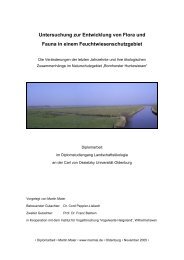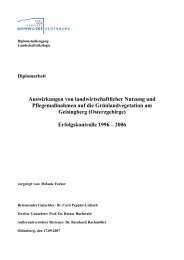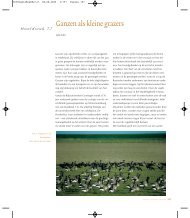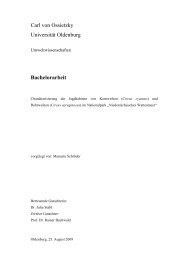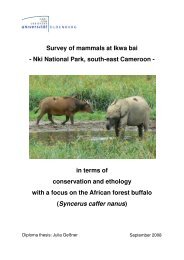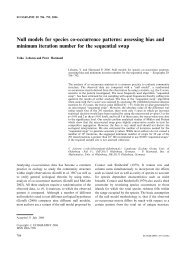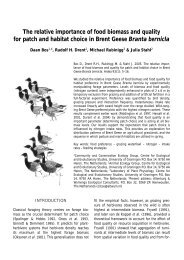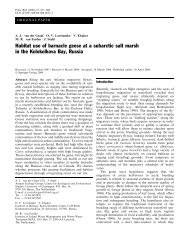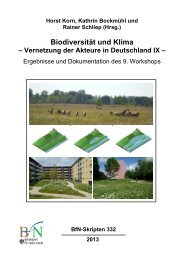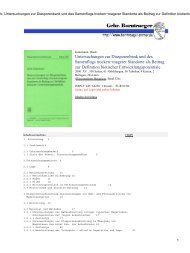The use of habitat models in conservation of rare and endangered ...
The use of habitat models in conservation of rare and endangered ...
The use of habitat models in conservation of rare and endangered ...
You also want an ePaper? Increase the reach of your titles
YUMPU automatically turns print PDFs into web optimized ePapers that Google loves.
246<br />
comprehensive review <strong>of</strong> <strong>habitat</strong> requirements <strong>and</strong><br />
host plants <strong>of</strong> Auchenorrhyncha species <strong>in</strong><br />
Germany. However, the <strong>in</strong>formation is qualitative<br />
<strong>and</strong> descriptive rather than quantified. For<br />
<strong>in</strong>stance, Neophilaenus m<strong>in</strong>or is described as preferr<strong>in</strong>g<br />
‘sparse cover <strong>of</strong> vegetation’. S<strong>in</strong>ce exact<br />
figures are not provided it rema<strong>in</strong>s unclear whether<br />
the optimum is at 20% vegetation cover, or if 50%<br />
is still tolerated. For this reason, data-based predictions<br />
<strong>of</strong> <strong>habitat</strong> suitability, especially at the<br />
l<strong>and</strong>scape level, are not feasible.<br />
Such predictions can be made with <strong>habitat</strong><br />
<strong>models</strong>. <strong>The</strong> aims <strong>of</strong> <strong>habitat</strong> <strong>models</strong> are tw<strong>of</strong>old<br />
(e.g. Guisan <strong>and</strong> Zimmermann 2000; Scott et al.<br />
2002). First, <strong>habitat</strong> <strong>models</strong> analyze <strong>and</strong> quantify<br />
the relationship between species’ abundance or<br />
occurrence <strong>and</strong> <strong>habitat</strong> factors. Second, they<br />
yield predictions <strong>of</strong> species’ abundance or<br />
occurrence given certa<strong>in</strong> environmental conditions.<br />
<strong>The</strong> latter makes <strong>habitat</strong> <strong>models</strong> a potentially<br />
powerful tool <strong>in</strong> nature <strong>conservation</strong>:<br />
<strong>models</strong> are able to predict the probability <strong>of</strong><br />
occurrence for sites or l<strong>and</strong>scapes where species<br />
distribution data are not available (Wilson et al.<br />
2005). <strong>The</strong>y can also be <strong>use</strong>d to assess the effects<br />
<strong>of</strong> l<strong>and</strong> <strong>use</strong> changes or succession on <strong>habitat</strong><br />
quality (Rudner et al. 2005). Habitat suitability<br />
maps which can be obta<strong>in</strong>ed from <strong>habitat</strong> <strong>models</strong><br />
identify potential core <strong>habitat</strong>s <strong>of</strong> species <strong>and</strong><br />
form the basis for the plann<strong>in</strong>g <strong>of</strong> nature reserves<br />
(e.g. Cabeza et al. 2004). Such predictions <strong>of</strong><br />
spatial distribution are essential, s<strong>in</strong>ce <strong>conservation</strong><br />
plann<strong>in</strong>g has to deal with the whole l<strong>and</strong>scape<br />
(Wilson et al. 2005).<br />
Here, we <strong>use</strong> presence–absence data <strong>of</strong> Auchenorrhyncha<br />
species <strong>and</strong> environmental data to<br />
build <strong>habitat</strong> <strong>models</strong> based on logistic regression.<br />
In two case studies – the <strong>rare</strong> leafhopper Verdanus<br />
bensoni <strong>in</strong> mounta<strong>in</strong>ous grassl<strong>and</strong>s <strong>and</strong> four<br />
<strong>endangered</strong> Auchenorrhyncha <strong>in</strong> urban brownfields<br />
– we (1) demonstrate the procedure <strong>of</strong> model<br />
build<strong>in</strong>g, <strong>in</strong>clud<strong>in</strong>g variable selection, classification<br />
<strong>and</strong> <strong>in</strong>ternal validation, (2) quantify <strong>habitat</strong><br />
requirements <strong>of</strong> selected species, (3) exemplify the<br />
construction <strong>of</strong> <strong>habitat</strong> suitability maps, <strong>and</strong> (4)<br />
discuss the application <strong>of</strong> <strong>habitat</strong> <strong>models</strong> <strong>in</strong> the<br />
<strong>conservation</strong> <strong>of</strong> Auchenorrhyncha, especially <strong>rare</strong><br />
<strong>and</strong> <strong>endangered</strong> species. Rare here is understood<br />
as locally restricted due to <strong>rare</strong> <strong>habitat</strong>; the species<br />
can well build up considerable densities <strong>in</strong> their<br />
<strong>habitat</strong>s.<br />
Methods<br />
Study sites<br />
Case study 1: Leafhopper Verdanus bensoni<br />
<strong>The</strong> first case study <strong>in</strong>vestigated <strong>habitat</strong> requirements<br />
<strong>of</strong> the leafhopper Verdanus bensoni (Ch<strong>in</strong>a,<br />
1933). It was conducted <strong>in</strong> the mounta<strong>in</strong> ranges <strong>of</strong><br />
Dreisessel (1332 m; 48°47¢ N, 13°48¢ E) <strong>and</strong> Arber<br />
(1456 m; 49°06¢ N, 13°08¢ E) <strong>in</strong> the Bavarian<br />
Forest, Germany. <strong>The</strong> climate is characterized by<br />
mean annual temperatures between 5 <strong>and</strong> 6 °C<br />
with annual precipitation between 900 (low altitudes)<br />
<strong>and</strong> 2000 mm (high altitudes). For details<br />
on climate, geology <strong>and</strong> soil types see H<strong>of</strong>mann<br />
(1984). <strong>The</strong> area is largely covered by forests.<br />
While at altitudes up to approx. 1200 m, mixed<br />
forests (ma<strong>in</strong>ly beech, fir <strong>and</strong> spruce) are predom<strong>in</strong>ant,<br />
above this altitude only spruce forests<br />
are found. In the valleys <strong>and</strong> at lower altitudes<br />
l<strong>and</strong> <strong>use</strong> is characterized by a mix <strong>of</strong> forests, pastures<br />
<strong>and</strong> fields. At higher altitudes only few patches<br />
<strong>of</strong> grassl<strong>and</strong> are scattered with<strong>in</strong> the forests,<br />
ma<strong>in</strong>ly small pastures (‘Schachten’, see H<strong>of</strong>mann<br />
1984) <strong>and</strong> ski runs.<br />
Verdanus bensoni has a scattered range <strong>and</strong> is<br />
restricted to European mounta<strong>in</strong> ranges (Nickel<br />
2003). Up to now, it has been recorded from the<br />
German Alps, Scottish Highl<strong>and</strong>s, Swiss <strong>and</strong><br />
French Jura, Bavarian <strong>and</strong> Bohemian Forest,<br />
Giant Mounta<strong>in</strong>s, <strong>and</strong> Ural Mounta<strong>in</strong>s. In<br />
Germany, Verdanus bensoni is a <strong>rare</strong> species <strong>in</strong> the<br />
Alps <strong>and</strong> the Bavarian Forest. It is listed <strong>in</strong> the<br />
Red Data Book (Remane et al. 1998). In the study<br />
area, the Bavarian Forest, V. bensoni was recorded<br />
above approx. 800 m a.s.l. (Biedermann unpubl.).<br />
V. bensoni was found <strong>in</strong> montane <strong>and</strong> alp<strong>in</strong>e<br />
grassl<strong>and</strong>s, probably feed<strong>in</strong>g on grasses<br />
(Biedermann 1998; Nickel 2003). However, the<br />
specific <strong>habitat</strong> requirements have not been studied<br />
yet <strong>in</strong> detail.<br />
Case study 2: Endangered species <strong>in</strong> urban<br />
brown-fields<br />
<strong>The</strong> second case study was carried out on<br />
brownfield sites <strong>in</strong> the city <strong>of</strong> Bremen, located <strong>in</strong><br />
the lowl<strong>and</strong>s <strong>of</strong> northwest Germany (8°44¢ N,<br />
53°05¢ E, mean temperature 8.8 °C, mean annual<br />
precipitation 694 mm). Urban brownfields, previously-developed<br />
l<strong>and</strong> with<strong>in</strong> cities, <strong>of</strong>ten support a<br />
rich wildlife <strong>and</strong> ho<strong>use</strong> a whole range <strong>of</strong> <strong>rare</strong> <strong>and</strong>




